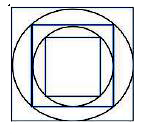On increasing each side of a square by 50%, the ratio of the area of new square formed and the given square will be
9:5
9:35
9:7
9:4
The correct Answer is:D
To solve the problem step by step, we will follow these instructions:
Step 1: Understand the problem
We need to find the ratio of the area of a new square formed after increasing each side of an original square by 50% to the area of the original square.
Step 2: Define the side length of the original square
Let the side length of the original square be L.
Step 3: Calculate the area of the original square
The area A1 of the original square is given by:
A1=L2
Step 4: Calculate the new side length after a 50% increase
Increasing each side by 50% means the new side length L′ is:
L′=L+0.5L=1.5L
Step 5: Calculate the area of the new square
The area A2 of the new square is:
A2=(L′)2=(1.5L)2=2.25L2
Step 6: Find the ratio of the areas
Now, we need to find the ratio of the area of the new square A2 to the area of the original square A1:
Ratio=A2A1=2.25L2L2
Step 7: Simplify the ratio
Since L2 cancels out, we have:
Ratio=2.25
Step 8: Express the ratio in fractional form
To express 2.25 as a fraction:
2.25=225100=94
Final Answer
Thus, the ratio of the area of the new square to the area of the original square is:
94
---
We need to find the ratio of the area of a new square formed after increasing each side of an original square by 50% to the area of the original square.
Let the side length of the original square be L.
The area A1 of the original square is given by:
A1=L2
Increasing each side by 50% means the new side length L′ is:
L′=L+0.5L=1.5L
The area A2 of the new square is:
A2=(L′)2=(1.5L)2=2.25L2
Now, we need to find the ratio of the area of the new square A2 to the area of the original square A1:
Ratio=A2A1=2.25L2L2
Since L2 cancels out, we have:
Ratio=2.25
To express 2.25 as a fraction:
2.25=225100=94
Thus, the ratio of the area of the new square to the area of the original square is:
94
Topper's Solved these Questions
- MENSURATIONBook:KIRAN PUBLICATIONChapter:MENSURATIONExercise:TYPE - III
Explore 21 Videos
- MENSURATIONBook:KIRAN PUBLICATIONChapter:MENSURATIONExercise:TYPE - IV
Explore 169 Videos
- MENSURATIONBook:KIRAN PUBLICATIONChapter:MENSURATIONExercise:Test Yourself
Explore 28 Videos
- LCM AND HCF Book:KIRAN PUBLICATIONChapter:LCM AND HCF Exercise:Test Yourself
Explore 18 Videos
- MISCELLANEOUSBook:KIRAN PUBLICATIONChapter:MISCELLANEOUSExercise:TYPE-VI
Explore 15 Videos
Similar Questions
Knowledge Check
If the side of a square is doubled, then the area of the square
Aremains sameBbecomes doubleCbecomes tripleDbecomes 4 timesIf the side of a square is doubled, then the area of the square
A1 : 2B2 : 1C3 : 1D4 : 1The radius of a circle is a side of a square. The ratio of the areas of the circle and the square is
A1:πBπ:1Cπ:2D2:π
On increasing each side of a square by 25%, the increase in area will be (a) 25% (b) 55% (c) 55.5% (d) 56.25%
View SolutionArea of a square is doubled if the side of the square is doubled.
View SolutionA circle and a square have same area. The ratio of the side of the square to the radius of the circle will be :
View SolutionIF the area of square is 25m2, then the side of the square is
View SolutionThe ratio of the area of a square to that of the square drawn on its diagonal is :
View Solution

